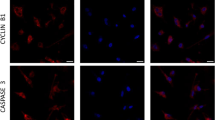Abstract
Induction of follicle stimulating hormone receptor in the granulosa cells of intact immature rat ovary by diethylstilbesterol, an estrogen, has been studied.
A single injection of 4 mg of diethylstilbesterol produced 72 h later a 3-fold increase in follicle stimulating hormone receptor concentration as monitored by [125I]-oFSH binding to isolated cells. The newly induced receptors were kinetically indistinguishable from the preexisting ones, as determined by Lineweaver-Burk plot of the binding data. The induced receptors were functional as evidenced by increased ability of the granulosa cells to incorporate [3H]-leucine into cellular proteins.
Neutralization of endogenous follicle stimulating hormone and luteinizing hormone by administering specific antisera had no effect on the ability of diethylstilbesterol to induce follicle stimulating hormone receptors, whereas blockade of endogenous prolactin secretion by ergobromocryptin administration significantly inhibited (∼ 30 %) the response to diethylstilbesterol; this inhibition could be completely relieved by ovine prolactin treatment. However, ovine prolactin at the dose tried did not by itself enhance follicle stimulating hormone receptor level.
Administration of ergobromocryptin to adult cycling rats at noon of proestrus brought about as measured on diestrusII, (a) a reduction of both follicle stimulating hormone (∼ 30 %) and luteinizing hormone (∼ 45 %) receptor concentration in granulosa cells, (b) a drastic reduction in the ovarian tissue estradiol with no change in tissue progesterone and (c) reduction in the ability of isolated granulosa cells to convert testosterone to estradiol in response to follicle stimulating hormone. Ergobromocryptin treatment affected only prolactin and not follicle stimulating hormone or luteinizing hormone surges on the proestrus evening. Treatment of rats with ergobromocryptin at proestrus noon followed by an injection of ovine prolactin (1 mg) at 1700 h of the same day completely reversed the ergobromocryptin induced reduction in ovarian tissue estradiol as well as the aromatase activity of the granulosa cells on diestrus II, thus suggesting a role for proestrus prolactin surge in the follicular maturation process
Similar content being viewed by others
Abbreviations
- FSH:
-
Follicle stimulating hormone
- LH:
-
luteinizing hormone
- DES:
-
diethylstilbesterol
- EBC:
-
ergobromocryptin
- hCG:
-
human chorionic gonadotropin
- PMSG:
-
pregnant mare serum gonadotropin
- Prl:
-
prolactin
References
Bergink, E. W., Kloosterboer, H. J., Gruber, M. and Ab, G. (1973)Biochim. Biophys. Acta,294, 497.
Demura, R., Ono, M., Demura, H., Shizume, K. and Oouchi, H. (1982)J.Clin. Endocrinol. Metab.,54, 1246.
Dorrington, J. H. and Gore-Langton, R. E. (1982)Endocrinology,110, 1701.
Dorrington, J. H., McKeracher, H. L, Chan, A. K. and Gore-Langton, R. E. (1983)J. Steroid. Biochem.,19, 17.
Giles, K. W. and Myers, A. (1965)Nature (London),206, 93.
Goldenberg, R. L., Vaitukaitis, J. L. and Ross, G. T. (1972)Endocrinology,90, 1492.
Greenwood, F. C, Hunter, W. M. and Glover, T. (1963)Biochem. J.,89, 114.
Holt, J. A. and Richards, J. S. (1975)The Endocrine Society, 57th Ann. Meeting, Abstr.64.
Ireland, J. J. and Richards, J. S. (1978)Endocrinology,102, 876.
Labrie, F., Drouin, J., Derland, L., Lagace, L., Beaulieu, M, DeLean, A., Kelly, P. A., Caron, M. C. and Raymond, V. (1978)Rec. Prog. Hor. Res.,34, 25.
Lineweaver, H. andBurk, D. (1934)J. Am. Chem. Soc,56, 658.
Louvet, J. P. and Vaitukaitis, J. L. (1976)Endocrinology,99, 758.
Maneckjee, R.s Moudgal, N. R. and Srinath, B. R. (1977)Fertil. Steril,28, 986.
McNatty, K. P. (1979)Fertil. Steril.,32, 433.
McNatty, K. P., Sawers, R. S. and McNeilly, A. S. (1974)Nature (London),250, 653.
Maurer, R. A. and Gorski, J. (1977)Endocrinology,101, 76.
Meites, J., Lu, K. H., Wuttke, W., Welsch, C. W., Nagasawa, H. and Quadri, S. K. (1972)Rec. Prog. Horm. Res.,28, 471.
Midgley, A. R. Jr. (1973)Adv. Exp. Biol. Med.,36, 365.
Mukku, V. R. and Moudgal., N. R. (1975)Endocrinology,97, 1455.
Murthy, U. S. and Adiga, P. R. (1978)Biochim. Biophys. Acta,538, 364.
Nakono, R., Mizuno, T., Katayama, K., Hayashi, K. and Tojo, S. (1975)Arch. Gynecol,218, 1.
Nimrod, A., Erickson, G. F. and Ryan, K. J. (1976)Endocrinology,98, 56.
Nimrod, A., Bedrak, E. and Lamprecht, S. A. (1977)Biochem. Biophys. Res. Commun.,78, 977.
Palmiter, R. D. (1975)Cell,4, 189.
Rao, M. C, Midgley, A. R. Jr. and Richards, J. S. (1978)Cell,14, 71.
Richards, J. S. (1979)Rec. Prog. Hor. Res.,35, 343.
Richards, J. S., Ireland, J. J., Rao, M. C, Bernath, G. A., Midgley, A. R. Jr. and Reichert, L. E. Jr. (1976)Endocrinology,99, 1562.
Richards, J. S. and Williams, J. J. (1976)Endocrinology,99, 1571.
Sheela Rani, C. S. and Moudgal, N. R. (1977)J. Reprod. Fertil,50, 37.
Sheela Rani, C. S., Salhanick, A. R. and Armstrong, D. T. (1981)Endocrinology,108, 1379.
Vidyashankar, N. and Moudgal., N. R. (1981)Arch. Biochem. Biophys.,209, 241.
Wang, C, Hsueh, A. J. W. and Erickson, G. F. (1979)J. Biol Chem.,254, 11330.
Zeleznik, A. J., Midgley, A. R. Jr. and Reichert, L. E. Jr. (1974)Endocrinology,95, 818.
Zyzek, E., Dufy-Barbe, L., Dufy, B. and Vincent, J. D. (1981)Biochem. Biophys. Res. Commun.,102, 1151.
Author information
Authors and Affiliations
Rights and permissions
About this article
Cite this article
Vidyashankar, N., Moudgal, N.R. Effect of diethylstilbesterol and prolactin on the induction of follicle stimulating hormone receptors in immature and cycling rats. J Biosci 6, 263–276 (1984). https://doi.org/10.1007/BF02716740
Received:
Revised:
Issue Date:
DOI: https://doi.org/10.1007/BF02716740




